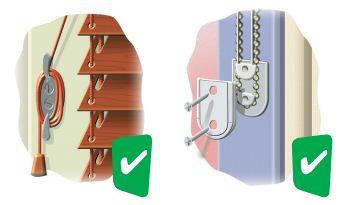Contact Consumer Protection
Tel: 1300 30 40 54
consumer@demirs.wa.gov.au
See all Consumer Protection office locations
Safety in and around a rental property is the responsibility of both the landlord and tenant.
The rental property must meet basic security, safety, and health standards. These include:
The landlord is responsible for the rental home being safe to live in. The landlord has a duty of care to tenants and anyone the tenant invites into the property.
The landlord may be sued for negligence if an injury or death occurs because the property is not safe. The landlord must:
The landlord must give the tennat(s) at the start of a tenancy a:
These forms cover safety concerns about:
These apply whether the tenants have children living in the premises or not.
Include a check of pool barriers and blind/curtain cords when doing property inspections.
Tenant(s) must ensure the rental home remains a safe environment by:
informing the landlord (in writing) of any safety issues around the home as soon as possible.
Landlords and tenants both have safety obligations for swimming and spa pools, including portable pools. Even a small portable pool with very little water, could cause a child to drown in seconds.
A pool or spa (but not a spa-bath) deeper than 30 cm (the size of an average ruler) must have safety barriers.
The landlord must provide and maintain safety barriers that comply with legislative requirements (Building Regulations 2012).
The tenant must keep climbable objects, such as furniture, away from the fence and gate. The tenant must not prop the gate open with object to prevent it from closing.
The tenant must let the landlord know if there is anything wrong with the fence, gate or latch. The landlord must fix the fence as an urgent repair.
Pool fencing laws apply to portable pools 30 cm deep or more.
Tenants should:
Landlords should include these conditions in the rental agreement.
See Building and Energy's Swimming, spa and portable pools safety page for more information about pool safety laws.
Blind cords or chains must be restrained to prevent accidental strangulations. This applies if there are children living at the home or not.
Detailed information is available on the blind and curtain cord safety page.
Tenants must:

Landlords
What types of internal window coverings are a safety hazard for children?
Anchoring furniture to a wall will prevent a child, or a person with a disability, from being hurt or killed.
The landlord should secure any furniture that may be a hazard if the home is rented furnished.
Tenants need to ask permission to anchor furniture to a wall by sending their landlord a request form.
When the landlord receives the request form, they must give permission, unless:
At the end of the tenancy, the tenant must:
For more information visit
Making changes to a rental home
Product Safety Australia's website on Toppling Furniture: Anchor it and protect a child
The rental home must have two RCDs installed on the switchboard before it can be leased. If your rental home does not have two RCDs, contact the landlord. They will need to organise a licensed electrician to install them.
Tenants should test the RCDs every three months to ensure their reliability. If the RCD does not operate they should inform the landlord. Faulty RCDs must be replaced immediately.
Energy Safety has more detailed information about RCDs.
All homes must have compliant mains powered smoke alarms before transfer of ownership, sale, rent or hire. This includes homes made available for short-term rental accommodation. Smoke alarms must be:
In rental properties, it is the landlord’s responsibility to ensure smoke alarms are maintained so they remain compliant.
The tenant is only responsible for changing a 9 volt battery where the alarm is easily accessible. They are not responsible if the alarm is difficult to reach such as on high ceilings or walls.
Smoke alarms with a 10-year battery life are only allowed where there is no hidden space to run the electrical wiring for mains powered smoke alarms (concrete ceiling, flat roof etc).
Tenants should test the smoke alarm monthly and replace the battery if needed.
All smoke alarms have a test button that, when pressed, indicate whether the alarm is working or not.
A $1,000 infringement notice could be issued for a home subject to sale, rent or hire, without a smoke alarm and a landlord or owner who offers a dwelling for hire, could be fined up to $5,000.
Smoke alarm laws fact sheet (Building and Energy)
Department of Fire and Emergency Services (DFES) has advice on smoke alarm maintenance.
Last modified: